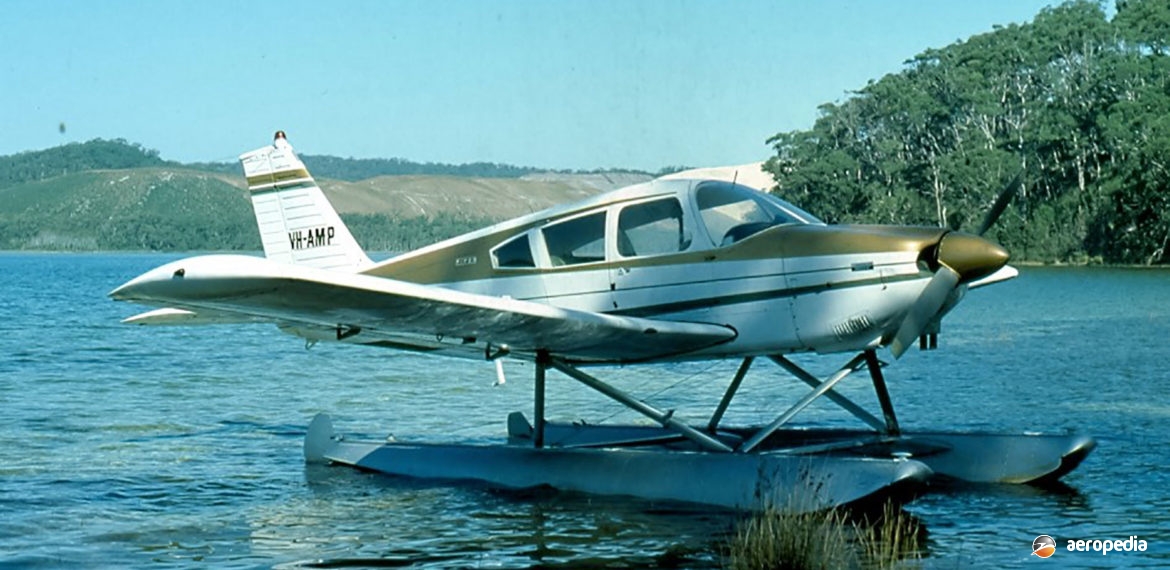Photograph:
Piper PA-28-180 Cherokee floatplane VH-AMP (c/n 28-5724) at Smiths Lake, NSW in April 1978 (David C Eyre)
Country of origin:
United States of America
Description:
Light cabin monoplane
Power Plant:
One 134 kw (180 hp) Avco Lycoming O-360-A3A four-cylinder horizontally-opposed air-cooled engine
Specifications:
Length: 7.32 m (24 ft)
Height: 2.23 m (7 ft 4 in)
Wing area: 15.79 m² (170 sq ft)
Max speed: 237 km/h (147 mph)
Max cruising speed at 75% power at 2,130 m (7,000 ft): 233 km/h (144 mph)
Initial rate of climb: 226 m/min (740 ft/min)
Service ceiling: 4,160 m (13,650 ft)
Range at max cruising speed with max fuel: 1,239 km (770 miles)
Absolute ceiling: 4,804 m (15,750 ft)
Range at 65% power: 1,448 km (900 miles)
Take-off run: 264 m (865 ft)
Landing distance from 15 m (50 ft): 425 m (1,392 ft)
Empty weight: 633 kg (1,395 lb)
Loaded weight: 1,110 kg (2,450 lb)
History:
When the Cherokee was released, it was the first completely new model from the Piper stable for some time, and it represented a major change in design philosophy for the Company. Designed to replace the PA-22 Tri-Pacer and Colt series, the Cherokee commenced as a four-seater fitted with 112 kw (150 hp) or 119 kw (160 hp) engines. Subsequently it was developed into the two-seat Model 140 with a 104 kw (140 hp) engine, a four-seater with a 134 kw (180 hp) engine, the Arrow series with a retractable undercarriage, and the larger Cherokee Six, Cherokee Seven, Lance, Saratoga etc. At the time production concluded, some 30,000 aircraft in the series with a fixed undercarriage had been built, this comprising 10,100 Model 140s, 10,200 Models 180 and 181, 5,000 Models 151 and 161, and 2,800 Models 235 and 236.
Designed to compete against the Cessna 150, 172 and 182 series, the PA-28 was a four-seat, low-wing cabin monoplane of all-metal stressed-skin construction fitted with a tricycle undercarriage, incorporating many new design features aimed at reducing production costs. The nose cowl, wingtips, fin and rudder caps were manufactured from fibreglass. The fuel tanks were fitted externally into the leading-edge of each wing. A laminar-flow wing with a span of 9.14 m (30 ft) and an area of 14.86 m² (160 sq ft) was utilised, with manually operated slotted flaps. A feature of the design was its simplicity, with some 1,200 parts being used in its construction. Fibreglass was used in the engine cowling, parts of the wing, fin, rudder and tailplane. The prototype PA-28 powered by a 119 kw (160 hp) engine first flew on 14 January 1960, the first production machine flying in February 1961 and deliveries to customers commencing shortly thereafter.
The first aircraft in the series in this region VH-FGM (c/n 28-56) was powered by a 119 kw (160 hp) Lycoming O-320B engine and was first registered in November 1961, being used as a demonstrator and displayed at an aviation event at Camden, NSW at about that time. This aircraft the following year becoming VH-UAQ. Subsequently the type became very popular both in Australia (666 registered) and New Zealand (146 registered).
In 1964 a two-seat version was added to the range and this, powered by a 104 kw (140 hp) Lycoming O-320-A2B engine, was used extensively by aero clubs and training organisations. This aircraft utilised the basic Cherokee airframe but had its accommodation restricted to two, early models having the Lycoming O-320 engine but this was replaced by the 112 kw (150 hp) variant of the same engine. Until the advent of the Tomahawk in 1979, the Cherokee and the Cessna 172 were the main types flown by the larger Australian aero clubs and many clubs had a fleet of the type. In 1965 a variant of the 140 series appeared known as the 140-4 with two rear seats for children, and in 1966 a variant of this became known as the 140B and had some detail refinements. This series was popular and continued with the C, D and E models before it was re-named the Cruiser in 1972. Later a simplified variant known as the Flite Liner was introduced for flying schools and these continued in production up to 1976, the Cruiser remaining in production until replaced by the PA-38 Tomahawk in 1978.

